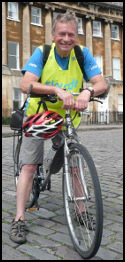Today the Government announced more cash to improve cycling. Welcome though this extra investment is for cycling, it smacks of being an afterthought and is only for some places in the UK. Where is the long term vision and overall policy for improvement across the country? Governments and local councils could then tailor funding to the strategy year on year. Why not switch the huge amount being invested in building new roads and widening motorways into cycling UK wide? The Government seems to be big on gestures but small on long term strategies.
On a local note there is funding for Bristol, so if this is paid through the West of England Transport Board there could be some for Bath and North east Somerset. However, even here we have no long term strategy yet.
A number of English cities and national parks are to share a £94m cash injection to promote cycling. Manchester, Leeds, Birmingham, Newcastle, Bristol, Cambridge, Oxford and Norwich will share £77m, with four national parks getting a further £17m. The money is to improve existing and fund new cycle routes. The government says it also wants to cut red tape to facilitate cyclist-friendly planning. Labour said roads had become less safe for cyclists under this government. Prime Minister David Cameron said he wanted to start “a cycling revolution”.
“Following our success in the Olympics, the Paralympics and the Tour de France, British cycling is riding high – now we want to see cycling soar,” he said. “This government wants to make it easier and safer for people who already cycle as well as encouraging far more people to take it up and business, local government, developers, road users and the transport sector all have a role to play in helping to achieve this.”Manchester alone will get £20m to build or improve some 30 miles of cycle paths and create new 20mph speed limit zones around the city. The national parks to benefit are the New Forest, Peak District, South Downs and Dartmoor. Major improvements to 93 miles of cycle routes on Dartmoor are anticipated.
The government has also announced a feasibility study to look at creating a new national cycleway broadly following the route of the HS2 rail line from London to Birmingham, Leeds and Manchester.
Ministers hope to emulate nationwide the popularity of cycling in London – where the number of cyclists has doubled over the past 10 years, according to one estimate.
“But pedal outside the city and the picture’s very different,” said BBC transport correspondent Richard Westcott. “Far more people prefer to drive, walk or catch the bus – in fact government statistics show that in 2012, just 2% of journeys in Britain were by bike.”
Malcolm Shepherd, chief executive of sustainable transport charity Sustrans, welcomed the initiative.
He said: “This is fantastic news for those living in the successful cities.
“Getting about by bike for everyday journeys could become a reality for people of all ages and abilities in those areas.
“We welcome the recognition that for the cycling revolution to become a way of life for us all this level of investment must be maintained and extended to all parts of the UK, including rural areas.”
But shadow transport secretary Maria Eagle said: “No amount of cynical spin from David Cameron will make up for the fact that, immediately on taking office, he axed Cycle England, the Cycle Demonstration Towns scheme and the annual £60m budget to support cycling that he inherited. “Since then he has axed targets to reduce deaths and serious injuries on our roads, reduced traffic enforcement, cut the THINK! awareness campaign and allowed longer HGVs.
“Only last month the prime minister set out plans for Britain’s roads that failed to include a single commitment to the investment in separated cycling infrastructure that is the best way to boost cycling and make it safer.”
She said Labour would, using the existing roads budget, deliver “long-term support for separated safe cycling routes and safer junctions”. “Tragically the number of cyclist deaths are now at a five-year high, reversing the progress that was starting to be made, and reports of new casualties are becoming a weekly occurrence,” she said.

 Hello, I'm Roger Symonds and I have created this blog to highlight local and wider cycling issues. Given the incredible interest and increase in cycling we must not miss this opportunity to provide the the infrastructure that gets even more people out on bikes in a safer environment.
Hello, I'm Roger Symonds and I have created this blog to highlight local and wider cycling issues. Given the incredible interest and increase in cycling we must not miss this opportunity to provide the the infrastructure that gets even more people out on bikes in a safer environment.